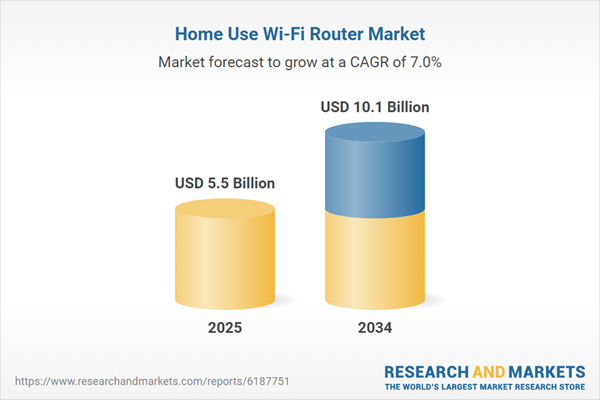The Home Use Wi-Fi Router market has evolved into a key segment of the consumer electronics space, driven by the exponential increase in connected devices and demand for seamless internet connectivity. With households increasingly reliant on high-speed internet for work-from-home setups, online education, streaming, and gaming, Wi-Fi routers have become an essential utility. Consumers are not only prioritizing speed and reliability but also enhanced coverage, security, and ease of use. The market features a variety of product types, including dual-band, tri-band, and mesh Wi-Fi systems designed to eliminate dead zones and ensure consistent performance. Growing awareness around cybersecurity and the emergence of smart homes have further elevated expectations from home routers, encouraging manufacturers to integrate advanced features like parental controls, AI-based traffic management, and WPA3 encryption. As demand intensifies, the competition among vendors is fueling innovation and affordability, enabling broader accessibility and adoption globally.
Throughout 2024, the Home Use Wi-Fi Router market experienced strong growth momentum fueled by continued remote work trends, increasing fiber broadband penetration, and the rapid deployment of Wi-Fi 6 and Wi-Fi 6E technologies. Manufacturers focused on product differentiation through improved antenna designs, mobile app control, and AI-powered bandwidth allocation. Mesh networking systems gained significant traction, particularly in large households and multi-story residences, as consumers sought consistent connectivity throughout their living spaces. Collaborations between router manufacturers and telecom providers also expanded, resulting in bundled offerings that enhanced value for consumers. Regional growth was notable in Asia-Pacific and Latin America, where rising internet penetration and urbanization drove router purchases. Additionally, sustainability gained attention, with brands introducing energy-efficient models and recyclable packaging as part of their eco-conscious marketing strategies. This shift in consumer preferences and the availability of feature-rich mid-range routers reinforced market competitiveness and accessibility.
The Home Use Wi-Fi Router market is expected to transition toward even more intelligent, adaptive, and sustainable solutions. The anticipated mainstream adoption of Wi-Fi 7 will usher in ultra-high-speed connections, lower latency, and improved support for dense device environments. Future routers will increasingly feature embedded AI to learn user habits, dynamically optimize bandwidth, and enhance network security autonomously. Integration with broader smart home ecosystems is projected to deepen, allowing seamless coordination with connected devices like smart TVs, thermostats, and security systems. Furthermore, user-friendly interfaces and simplified setup processes will remain a design priority as consumer tech literacy widens. Growth in rural broadband infrastructure and government-driven connectivity initiatives will unlock new opportunities in underserved regions. As competition intensifies, manufacturers will likely focus on subscription-based services and firmware updates to provide ongoing value, while simultaneously addressing the rising importance of data privacy and cyber protection in a hyper-connected world.
Key Insights: Home Use Wi-Fi Router Market
- Mesh Wi-Fi systems are becoming the preferred choice for households seeking seamless, wall-to-wall connectivity without signal degradation.
- Wi-Fi 6 and 6E adoption continues to accelerate, offering enhanced speeds, capacity, and battery efficiency for connected devices.
- Integration of smart features like voice control, AI-based network management, and app-based control is improving user experience.
- Growing consumer interest in energy-efficient and eco-friendly routers is shaping product design and marketing strategies.
- Security-centric features such as VPN support, malware protection, and parental controls are gaining importance in product differentiation.
- Rising number of connected devices in households is driving demand for routers capable of supporting multi-device, high-bandwidth environments.
- Expansion of high-speed internet infrastructure globally is boosting the need for compatible, high-performance home Wi-Fi routers.
- Remote work, online education, and streaming services have made reliable home internet an essential utility for daily life.
- Smart home adoption is encouraging integration-ready routers that can manage and protect IoT device connectivity.
- Rapid technological advancements result in shorter product lifecycles, forcing consumers to upgrade frequently and causing challenges in maintaining compatibility and reducing e-waste.
Home Use Wi-Fi Router Market Segmentation
By Type
- Speed and Capacity
- Wi-Fi Standards
By Technology
- Dual-Band and Tri-Band Routers
- Mesh Wi-Fi Systems
By Application
- Gaming Routers
- Streaming Routers
- General-Use Routers
Key Companies Analysed
- Google LLC
- Samsung Electronics Co. Ltd.
- Huawei Technologies Co. Ltd.
- ASUSTeK Computer Inc.
- Motorola Solutions Inc.
- NortonLifeLock Inc.
- TP-Link Corporation Limited
- Ubiquiti Networks Inc.
- Netgear Inc.
- D-Link Corporation
- ASRock Inc.
- ZyXEL Communications Corporation
- MikroTik
- Edimax Technology Co. Ltd.
- Billion Electric Co. Ltd.
- Shenzhen Tenda Technology Co. Ltd.
- Linksys Holdings Inc.
- Securifi Inc.
- EnGenius Technologies Inc.
- Keenetic Limited
- Open Mesh Inc.
- Gryphon Online Safety Inc.
- MERCUSYS Technologies Co. Ltd.
- ARRIS International plc
Home Use Wi-Fi Router Market Analytics
The report employs rigorous tools, including Porter’s Five Forces, value chain mapping, and scenario-based modeling, to assess supply-demand dynamics. Cross-sector influences from parent, derived, and substitute markets are evaluated to identify risks and opportunities. Trade and pricing analytics provide an up-to-date view of international flows, including leading exporters, importers, and regional price trends.Macroeconomic indicators, policy frameworks such as carbon pricing and energy security strategies, and evolving consumer behavior are considered in forecasting scenarios. Recent deal flows, partnerships, and technology innovations are incorporated to assess their impact on future market performance.
Home Use Wi-Fi Router Market Competitive Intelligence
The competitive landscape is mapped through proprietary frameworks, profiling leading companies with details on business models, product portfolios, financial performance, and strategic initiatives. Key developments such as mergers & acquisitions, technology collaborations, investment inflows, and regional expansions are analyzed for their competitive impact. The report also identifies emerging players and innovative startups contributing to market disruption.Regional insights highlight the most promising investment destinations, regulatory landscapes, and evolving partnerships across energy and industrial corridors.
Countries Covered
- North America - Home Use Wi-Fi Router market data and outlook to 2034
- United States
- Canada
- Mexico
- Europe - Home Use Wi-Fi Router market data and outlook to 2034
- Germany
- United Kingdom
- France
- Italy
- Spain
- BeNeLux
- Russia
- Sweden
- Asia-Pacific - Home Use Wi-Fi Router market data and outlook to 2034
- China
- Japan
- India
- South Korea
- Australia
- Indonesia
- Malaysia
- Vietnam
- Middle East and Africa - Home Use Wi-Fi Router market data and outlook to 2034
- Saudi Arabia
- South Africa
- Iran
- UAE
- Egypt
- South and Central America - Home Use Wi-Fi Router market data and outlook to 2034
- Brazil
- Argentina
- Chile
- Peru
Research Methodology
This study combines primary inputs from industry experts across the Home Use Wi-Fi Router value chain with secondary data from associations, government publications, trade databases, and company disclosures. Proprietary modeling techniques, including data triangulation, statistical correlation, and scenario planning, are applied to deliver reliable market sizing and forecasting.Key Questions Addressed
- What is the current and forecast market size of the Home Use Wi-Fi Router industry at global, regional, and country levels?
- Which types, applications, and technologies present the highest growth potential?
- How are supply chains adapting to geopolitical and economic shocks?
- What role do policy frameworks, trade flows, and sustainability targets play in shaping demand?
- Who are the leading players, and how are their strategies evolving in the face of global uncertainty?
- Which regional “hotspots” and customer segments will outpace the market, and what go-to-market and partnership models best support entry and expansion?
- Where are the most investable opportunities - across technology roadmaps, sustainability-linked innovation, and M&A - and what is the best segment to invest over the next 3-5 years?
Your Key Takeaways from the Home Use Wi-Fi Router Market Report
- Global Home Use Wi-Fi Router market size and growth projections (CAGR), 2024-2034
- Impact of Russia-Ukraine, Israel-Palestine, and Hamas conflicts on Home Use Wi-Fi Router trade, costs, and supply chains
- Home Use Wi-Fi Router market size, share, and outlook across 5 regions and 27 countries, 2023-2034
- Home Use Wi-Fi Router market size, CAGR, and market share of key products, applications, and end-user verticals, 2023-2034
- Short- and long-term Home Use Wi-Fi Router market trends, drivers, restraints, and opportunities
- Porter’s Five Forces analysis, technological developments, and Home Use Wi-Fi Router supply chain analysis
- Home Use Wi-Fi Router trade analysis, Home Use Wi-Fi Router market price analysis, and Home Use Wi-Fi Router supply/demand dynamics
- Profiles of 5 leading companies - overview, key strategies, financials, and products
- Latest Home Use Wi-Fi Router market news and developments
Additional Support
With the purchase of this report, you will receive:- An updated PDF report and an MS Excel data workbook containing all market tables and figures for easy analysis.
- 7-day post-sale analyst support for clarifications and in-scope supplementary data, ensuring the deliverable aligns precisely with your requirements.
- Complimentary report update to incorporate the latest available data and the impact of recent market developments.
This product will be delivered within 1-3 business days.
Table of Contents
Companies Mentioned
- Google LLC
- Samsung Electronics Co. Ltd.
- Huawei Technologies Co. Ltd.
- ASUSTeK Computer Inc.
- Motorola Solutions Inc.
- NortonLifeLock Inc.
- TP-Link Corporation Limited
- Ubiquiti Networks Inc.
- Netgear Inc.
- D-Link Corporation
- ASRock Inc.
- ZyXEL Communications Corporation
- MikroTik
- Edimax Technology Co. Ltd.
- Billion Electric Co. Ltd.
- Shenzhen Tenda Technology Co. Ltd.
- Linksys Holdings Inc.
- Securifi Inc.
- EnGenius Technologies Inc.
- Keenetic Limited
- Open Mesh Inc.
- Gryphon Online Safety Inc.
- MERCUSYS Technologies Co. Ltd.
- ARRIS International PLC
Table Information
| Report Attribute | Details |
|---|---|
| No. of Pages | 160 |
| Published | October 2025 |
| Forecast Period | 2025 - 2034 |
| Estimated Market Value ( USD | $ 5.5 Billion |
| Forecasted Market Value ( USD | $ 10.1 Billion |
| Compound Annual Growth Rate | 6.9% |
| Regions Covered | Global |
| No. of Companies Mentioned | 24 |









